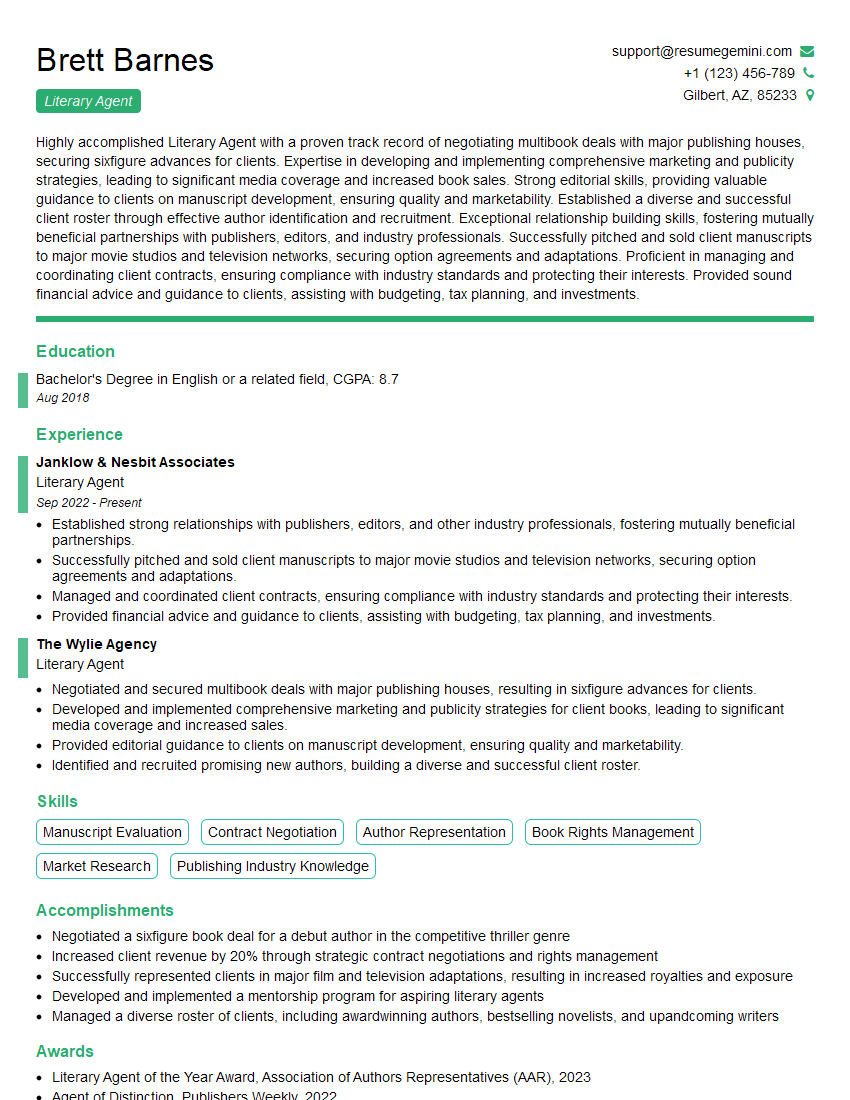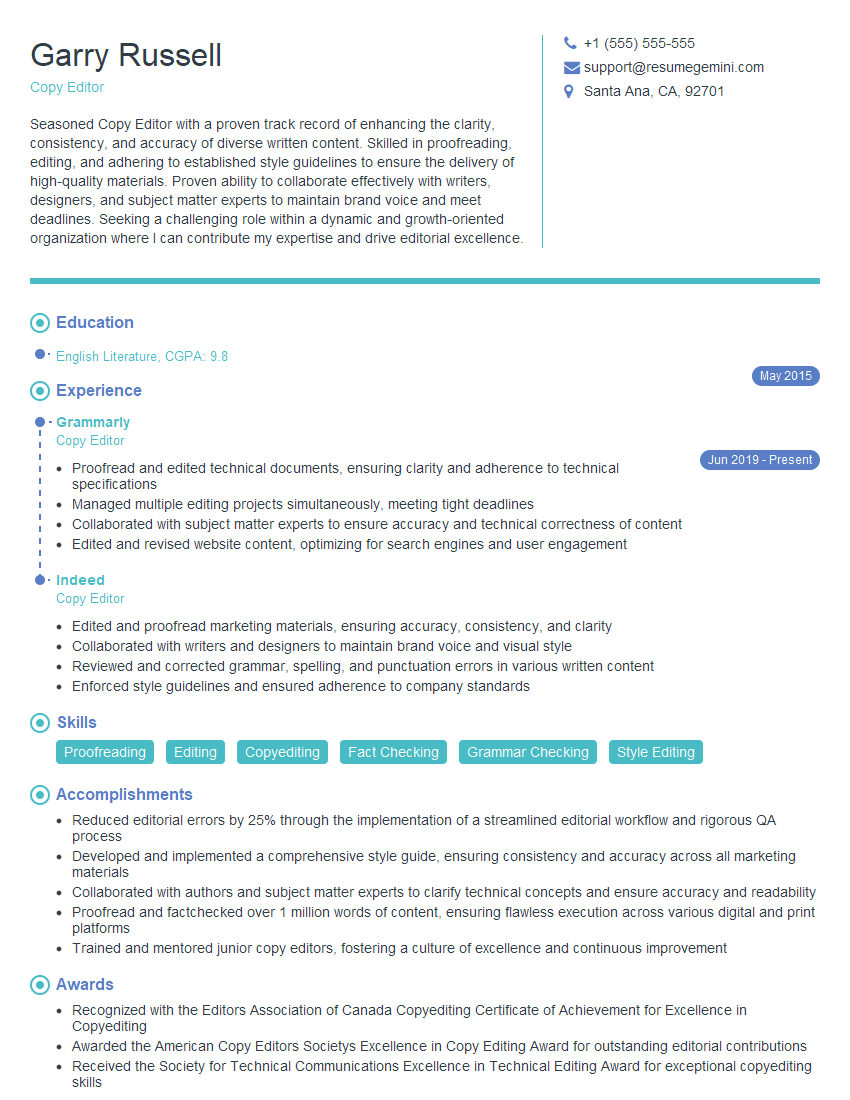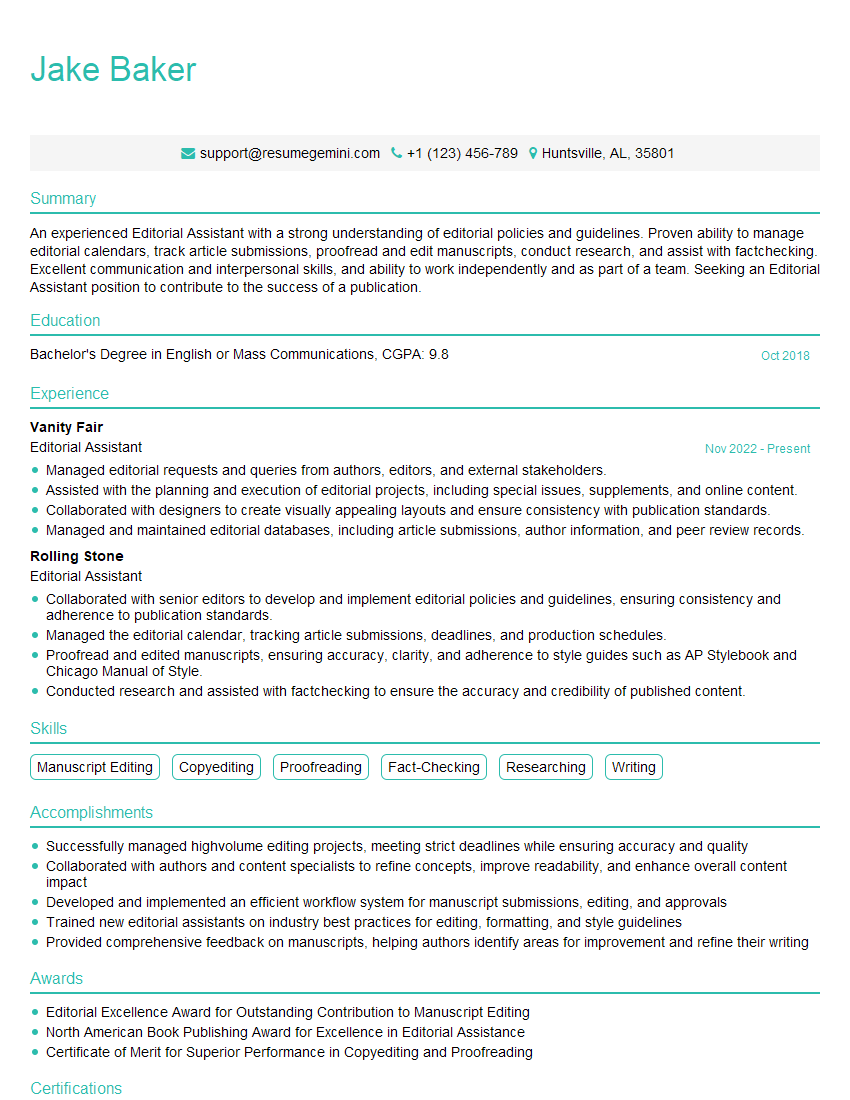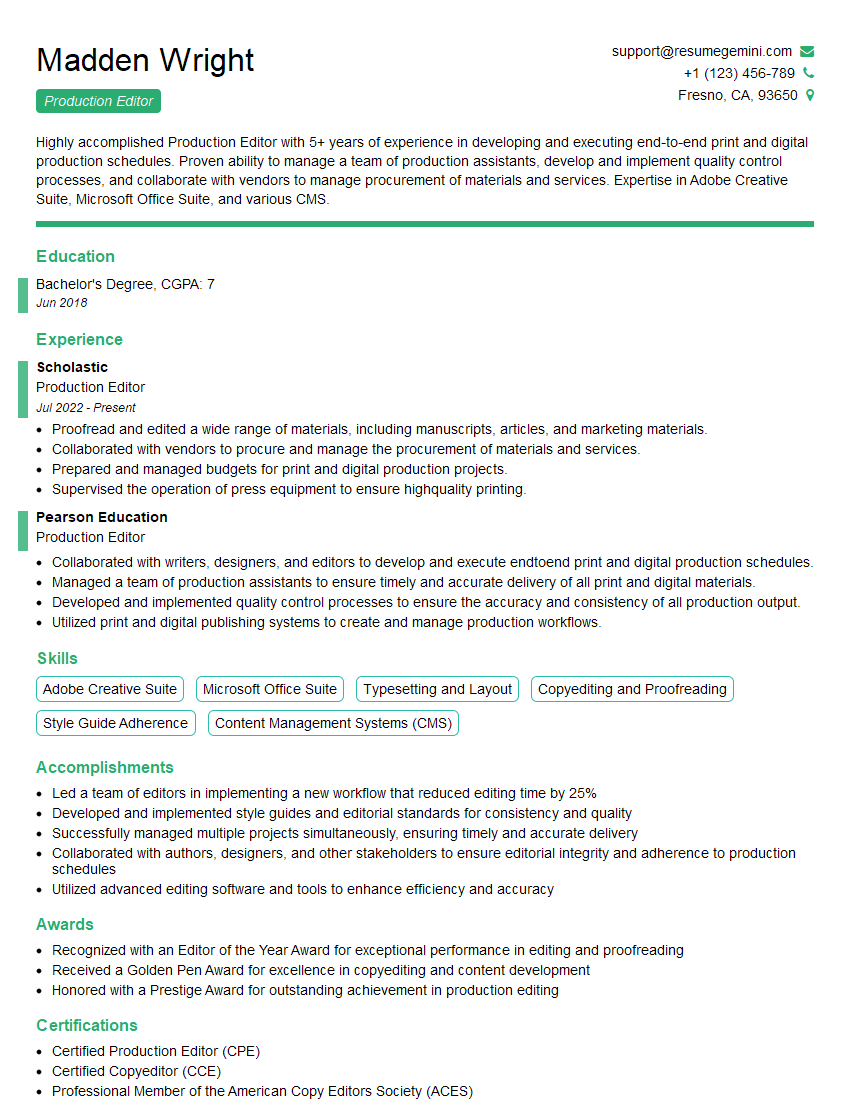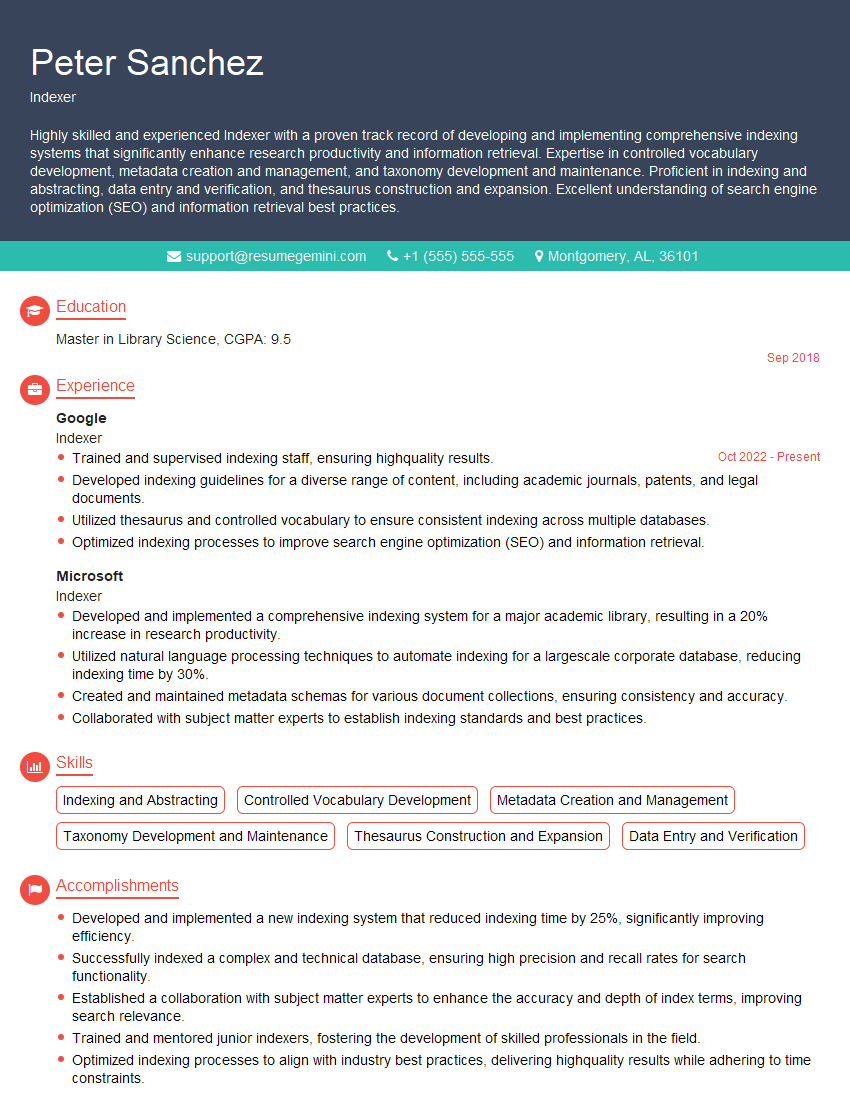Every successful interview starts with knowing what to expect. In this blog, we’ll take you through the top Working with Authors interview questions, breaking them down with expert tips to help you deliver impactful answers. Step into your next interview fully prepared and ready to succeed.
Questions Asked in Working with Authors Interview
Q 1. Describe your experience managing author expectations.
Managing author expectations is crucial for a smooth publishing process. It involves setting clear, realistic goals from the outset and maintaining open communication throughout. This includes transparently discussing timelines, outlining the editorial process, and managing the author’s understanding of the revisions process and potential delays.
For instance, I always begin by providing a detailed project timeline, including key deadlines and potential milestones. I also emphasize the iterative nature of the editing process, explaining that revisions are expected and are a normal part of improving the manuscript. I proactively share updates, addressing any concerns promptly, even if it’s to say ‘no news is good news’ and reaffirm the project is on track. This proactive approach prevents misunderstandings and fosters trust.
In one instance, an author expected immediate feedback on a lengthy manuscript. I explained that a thorough review would require time, outlining the stages of review and providing estimated timelines for each. By setting clear expectations from the beginning and providing regular updates, I managed to keep the author informed and satisfied.
Q 2. How do you handle conflicting deadlines with multiple authors?
Handling conflicting deadlines with multiple authors requires meticulous planning and prioritization. I utilize project management tools to create a central hub for all deadlines and tasks. I also engage in open communication with each author, clearly explaining the project’s overall timeline and prioritizing submissions based on various factors, such as publication deadlines and the current status of each manuscript.
A crucial element is maintaining flexibility. I build buffer time into the schedule to accommodate unexpected delays or challenges. If conflicts arise, I prioritize clear, empathetic communication, working with authors individually to find solutions that are mutually acceptable and accommodate their needs and the project’s overall success. This may involve adjusting deadlines in consultation, or re-prioritizing tasks, always aiming for a collaborative solution that prioritizes the quality of the final product.
For example, I once had two authors with conflicting deadlines for a two-part publication. By carefully reviewing the dependencies and talking through the process with each author, we negotiated a slight delay on one manuscript, allowing the other to publish on time without compromising quality.
Q 3. Explain your process for reviewing and providing feedback on manuscripts.
My manuscript review process is structured to provide constructive and actionable feedback. It involves a multi-stage approach: initial assessment of the manuscript’s strengths and weaknesses, followed by detailed line editing, focusing on grammar, style, and clarity. Next comes a substantive edit, addressing the manuscript’s overall structure, argumentation, and coherence. Finally, a copyedit checks for consistency and accuracy.
Each stage incorporates specific feedback methods. For line editing, I use track changes to clearly show revisions and suggestions. For substantive edits, I provide detailed comments and suggestions, explaining the reasoning behind each. Throughout the process, I maintain a professional and supportive tone, emphasizing the author’s strengths and focusing on achieving their best possible work. Feedback is always framed constructively, aiming to improve rather than criticize.
For example, if a manuscript lacks a strong narrative arc, I wouldn’t simply say ‘this is bad’; instead, I’d suggest specific strategies to improve the flow, perhaps offering examples from other works to illustrate my point.
Q 4. What strategies do you employ to build and maintain positive author relationships?
Building and maintaining positive author relationships requires proactive communication, respect, and empathy. I focus on building rapport from the initial contact, clearly outlining expectations and responsibilities. Regular check-ins are crucial, not only to discuss progress but also to foster a collaborative environment. I value author feedback and proactively solicit their input, making them feel heard and valued.
Active listening is key. Understanding an author’s goals, concerns, and working style allows me to tailor my approach to best suit their needs. I also maintain a professional yet personable demeanor, treating each author with respect and understanding, acknowledging their expertise and contributions. Celebrating successes, both big and small, along the way helps to foster positive feelings and collaboration.
I remember one author who was particularly anxious about the publication process. By regularly checking in, offering reassurance and celebrating each milestone, I was able to build a strong working relationship and ease their concerns, resulting in a successful publication.
Q 5. How do you identify and address potential conflicts of interest with authors?
Identifying and addressing potential conflicts of interest is paramount to maintaining ethical standards and ensuring the integrity of the publishing process. This begins with a thorough review of each author’s disclosure statement and a transparent discussion about any potential conflicts that could arise. I utilize a disclosure form that covers funding sources, affiliations, previous publications, and any other potential conflicts.
If a conflict of interest is identified, I thoroughly evaluate its nature and potential impact. This involves determining whether the conflict poses a genuine threat to objectivity and fairness. If so, I work collaboratively with the author to find solutions, such as modifying the manuscript, adding disclaimers, or seeking advice from the ethics committee. Documentation of this process is carefully maintained for transparency and accountability.
For example, if an author receives funding from a company whose products are mentioned in their manuscript, I’d discuss this openly, ensuring full transparency in the publication, possibly recommending specific modifications to address any bias or to clearly mention the funding.
Q 6. Describe your experience with contract negotiation.
My experience with contract negotiation involves a collaborative approach focusing on mutual understanding and benefit. I start by carefully reviewing the author’s proposal, clarifying any ambiguities and assessing its feasibility before engaging in negotiations. I explain the terms clearly and concisely, answering any questions the author might have. I strive to create a fair agreement that protects both the author’s rights and the publisher’s interests.
The negotiation process itself is one of open dialogue. I listen to the author’s concerns and preferences, aiming to find common ground. If disagreements arise, I offer alternative solutions, always striving to reach a mutually acceptable compromise. Flexibility and a willingness to negotiate are key to a successful outcome, ensuring both sides feel fairly represented and are committed to the collaboration.
In one instance, an author wanted more favorable royalty rates. We engaged in a constructive discussion, reviewing market standards and considering the projected sales, ultimately arriving at a mutually agreeable rate that balanced the author’s needs and the publisher’s viability.
Q 7. How familiar are you with different publishing contracts and agreements?
I am thoroughly familiar with various publishing contracts and agreements, including those for books, journals, and other scholarly works. My understanding encompasses different types of contracts, such as work-for-hire agreements, royalty agreements, and open-access publishing agreements. I am knowledgeable about the key clauses within each, such as copyright ownership, royalty rates, publication timelines, and termination clauses.
My understanding also extends to different publishing models, such as traditional publishing, self-publishing, and hybrid publishing. I understand the implications of each model on author rights and responsibilities. I’m adept at identifying potential risks and benefits for authors within each agreement, and I prioritize ensuring authors understand the implications before signing any agreement. I can advise authors on their rights and ensure they sign contracts that accurately reflect their understanding and expectations.
For example, I can readily distinguish between a traditional publishing contract, where the publisher owns the copyright, and a self-publishing agreement, where the author retains copyright. I can explain the pros and cons of each, helping an author make an informed decision that best suits their goals.
Q 8. What is your experience with copyright and intellectual property issues?
Copyright and intellectual property (IP) are fundamental to working with authors. Copyright protects the author’s original work, while IP encompasses all forms of creative expression, including the manuscript itself, any derivative works, and even the title. My experience includes a thorough understanding of copyright law, including fair use, work-for-hire agreements, and international copyright conventions. I’m proficient in drafting and reviewing contracts that clearly define ownership, usage rights, and compensation. For example, I’ve successfully negotiated contracts that ensured authors retained certain rights while granting the publisher sufficient license for publication and distribution. I also understand the complexities of handling multiple rights holders, such as when an author holds subsidiary rights to their work. I’ve successfully navigated situations where authors sought to reclaim rights or when issues arose regarding plagiarism or infringement. My approach is proactive, aiming to prevent disputes by ensuring clear contractual agreements and educated decision-making upfront.
Q 9. How do you track and manage author royalties?
Tracking and managing author royalties requires meticulous record-keeping and a robust system. I utilize specialized software designed for royalty accounting, which automates many aspects of the process. This software allows us to accurately track sales figures from various platforms (print, ebook, audiobook, etc.), calculate royalties based on agreed-upon percentages, and generate timely and accurate royalty statements for our authors. Beyond the software, I maintain detailed spreadsheets and internal documentation for audit trails. For example, I’ve successfully implemented a system that flags discrepancies in sales data and automatically alerts me to potential issues. Open communication with authors about payment schedules and royalty statements is paramount. I often proactively share sales updates, offering transparency and building trust. Regular reconciliation and audits help to maintain accuracy and identify any errors before they escalate into disputes.
Q 10. What are your preferred methods for communication with authors?
My preferred methods for communicating with authors involve a multi-channel approach, tailored to each author’s preferences. Email is the primary mode of communication for formal updates, contract negotiations, and critical information. However, I also utilize video conferencing for more complex discussions or when building rapport is crucial. For instance, I’ve found video calls especially useful during the initial manuscript review stage, allowing for more nuanced feedback and a more personal connection. Instant messaging platforms can be used for quick questions and less formal updates. I always maintain a professional tone while striving for timely responses, keeping in mind that authors often have tight deadlines and require prompt attention.
Q 11. How do you handle sensitive or difficult situations with authors?
Handling sensitive or difficult situations with authors requires tact, empathy, and effective communication. My approach centers on active listening, understanding the author’s perspective, and working collaboratively to find a mutually agreeable solution. I strive to create a safe space for open and honest dialogue, focusing on the underlying issues rather than getting bogged down in emotional exchanges. For example, I’ve successfully navigated disputes over editorial changes by calmly explaining the rationale behind the edits and finding compromises that satisfied both the author and the editorial vision. If a resolution cannot be reached directly, I involve senior team members or utilize mediation services. Maintaining detailed records of all communications and agreements is crucial for transparency and protection.
Q 12. How familiar are you with various author platforms and tools?
I’m very familiar with a wide range of author platforms and tools, including manuscript management systems, royalty tracking software, and author websites. My experience includes using platforms such as [mention specific platforms, e.g., Manuscript Manager, Author Central, etc.], each offering unique features for manuscript tracking, collaboration, and royalty reporting. Understanding the strengths and limitations of various platforms allows me to select the optimal tools for each project and author. This familiarity also extends to understanding different self-publishing platforms and their implications for authors’ rights and financial considerations. I’m comfortable training authors on the use of these tools, ensuring that they feel comfortable using the technology to manage their own work and finances effectively.
Q 13. Describe your approach to collaboration within a publishing team.
Collaboration is key in publishing. My approach emphasizes open communication, clear roles and responsibilities, and a shared commitment to the author’s success. I utilize project management software to track progress, assign tasks, and ensure deadlines are met. Regular team meetings allow us to discuss challenges, brainstorm solutions, and maintain alignment on project goals. For example, I’ve successfully implemented a system where editors, designers, and marketing teams share information seamlessly, preventing misunderstandings and delays. I believe in fostering a supportive and collaborative environment where everyone’s expertise is valued and utilized effectively. Open feedback and constructive criticism are encouraged, promoting growth and quality within the team.
Q 14. What is your experience with manuscript editing and proofreading?
My experience with manuscript editing and proofreading is extensive. I understand the nuances of grammar, style, punctuation, and consistency. I’m proficient in different editing styles (Chicago, MLA, APA etc.) and can adapt my approach to meet the specific requirements of a project. My editing process typically involves a comprehensive review of the manuscript, identifying areas requiring improvement in clarity, flow, and accuracy. I work closely with authors to implement these changes, ensuring their vision is maintained while enhancing the quality of the writing. My proofreading skills ensure the final product is free of typographical errors, grammatical inconsistencies, and formatting issues. For example, I’ve successfully worked on manuscripts requiring significant structural editing, as well as those needing only minor copyedits and proofreading. I always strive to maintain a balance between author intent and editorial best practices.
Q 15. How do you prioritize tasks and manage time effectively when working with multiple authors?
Managing multiple authors requires a robust system for prioritizing tasks and time. I utilize project management software, like Asana or Trello, to create individual author project boards, each with clearly defined milestones and deadlines. This allows me to visualize the workflow for each project and identify potential bottlenecks early on. I prioritize tasks based on deadlines, urgency, and the author’s individual needs. For example, if an author is nearing a critical deadline for a key chapter, that task takes precedence over less urgent tasks for other authors. I also dedicate specific blocks of time for focused work on individual author projects, minimizing context switching and maximizing efficiency. Regular check-ins and communication are crucial – I schedule weekly meetings with authors to discuss progress, address concerns, and adjust timelines as needed.
Career Expert Tips:
- Ace those interviews! Prepare effectively by reviewing the Top 50 Most Common Interview Questions on ResumeGemini.
- Navigate your job search with confidence! Explore a wide range of Career Tips on ResumeGemini. Learn about common challenges and recommendations to overcome them.
- Craft the perfect resume! Master the Art of Resume Writing with ResumeGemini’s guide. Showcase your unique qualifications and achievements effectively.
- Don’t miss out on holiday savings! Build your dream resume with ResumeGemini’s ATS optimized templates.
Q 16. How do you ensure the timely completion of projects within budget constraints?
Ensuring timely completion and staying within budget requires meticulous planning and proactive management. Before a project begins, a detailed budget is created, outlining all anticipated costs, including author advances, editing fees, design costs, marketing expenses, and printing/distribution (if applicable). This budget is then broken down into manageable phases, with milestones tied to specific budget allocations. Regular budget tracking is crucial – I use spreadsheets to monitor expenses against the budget, alerting me to any potential overruns early on. Proactive communication with authors about potential budget impacts is essential. For instance, if an author requests extensive revisions that exceed the allocated budget, we discuss alternatives or adjustments to maintain fiscal responsibility.
Q 17. What is your understanding of the publishing industry’s current trends?
The publishing industry is undergoing a significant transformation. We are seeing a rise in self-publishing, driven by accessible digital tools and platforms. This requires publishers to adapt by offering hybrid models that combine traditional publishing services with support for authors who wish to retain greater control over their work. Simultaneously, there’s a growing demand for diverse voices and representation in literature, impacting the types of stories being acquired and published. Furthermore, the increasing popularity of audiobooks and e-books necessitates a multi-format approach to publishing. Finally, data analytics is becoming increasingly crucial for understanding reader preferences and tailoring marketing strategies.
Q 18. How do you adapt to changing author needs and demands?
Adapting to changing author needs is fundamental to success. I foster open communication channels, encouraging authors to express their concerns or requests promptly. Active listening and empathy are key – understanding the author’s perspective is crucial for finding effective solutions. For example, if an author unexpectedly requires an extension, I work with them to create a revised timeline and communicate this to all relevant stakeholders. I also stay updated on industry best practices and technological advancements, such as using collaborative writing platforms to facilitate real-time feedback and revisions. This adaptability ensures a positive and productive author-publisher relationship.
Q 19. What is your approach to problem-solving in relation to author projects?
My approach to problem-solving involves a systematic, collaborative process. When a problem arises, I begin by clearly defining the issue and gathering all relevant information from the author and other stakeholders. I then brainstorm potential solutions, considering their feasibility and impact. This often involves weighing the creative vision of the author against practical constraints, such as budget or timeline. Once a solution is selected, I document it clearly and ensure all parties understand their roles and responsibilities in implementing it. Regular follow-ups are critical to ensure the solution is effective and doesn’t create new challenges. For example, if a conflict arises between the author and editor regarding stylistic choices, I facilitate a discussion to find a mutually agreeable solution.
Q 20. How do you ensure quality control throughout the publishing process?
Quality control is built into every stage of the publishing process. This begins with thorough manuscript evaluation and editorial review, where we assess clarity, consistency, and overall quality. Subsequently, rigorous proofreading and copyediting are implemented to catch any errors in grammar, style, or fact. For design and layout, we have a team of experienced professionals who ensure visual appeal and consistency. Finally, prior to publication, a pre-publication check is conducted to confirm that all elements – manuscript, design, and metadata – are correct and ready for release. This multi-layered approach ensures a high-quality final product that meets the expectations of both the author and the readership.
Q 21. How would you handle a situation where an author misses a deadline?
If an author misses a deadline, I immediately initiate a conversation to understand the reason. Empathy is crucial; there may be extenuating circumstances. However, regardless of the reason, a revised timeline needs to be established. This requires open communication and a collaborative approach. I would work with the author to determine a realistic new deadline, possibly adjusting other project elements to accommodate the delay. In certain cases, where delays are excessive or impact other aspects of the project significantly, we may need to reconsider the project’s feasibility. Documentation of the delay, the agreed-upon solution, and any potential consequences is essential for transparency and accountability.
Q 22. Explain your experience with marketing and publicity for authors.
My experience in author marketing and publicity spans over ten years, encompassing a wide range of strategies. I’ve successfully launched books across various genres, from literary fiction to self-help, using a multi-pronged approach. This includes developing targeted marketing campaigns that leverage social media, email marketing, traditional media outreach (press releases, media kits), and influencer collaborations. For example, I orchestrated a successful campaign for a debut novelist by securing a feature in a major literary magazine, resulting in a significant increase in pre-orders. Another successful campaign involved creating engaging video content featuring the author discussing their book’s themes, which boosted online engagement and sales. I’m also adept at managing author websites and utilizing data analytics to refine marketing strategies for optimal results. This data-driven approach allows for continuous improvement and ensures we maximize reach and impact.
Q 23. How familiar are you with different types of author events and appearances?
I’m well-versed in organizing and executing a variety of author events and appearances. These range from intimate book signings and author talks at local bookstores to larger-scale events like literary festivals and conferences. I’ve also coordinated virtual events, leveraging online platforms for author readings, Q&A sessions, and workshops. My experience includes managing logistics, such as venue booking, scheduling, promotion, and coordinating with event organizers. I understand the nuances of each event type and tailor my approach to meet the author’s goals and the target audience. For instance, for a younger audience, we might opt for an interactive book launch party, whereas a more scholarly audience might benefit from an academic panel discussion. I’m also experienced in managing media appearances, including interviews on podcasts, radio, and television.
Q 24. How do you measure the success of author collaborations?
Measuring the success of author collaborations requires a multifaceted approach. It goes beyond simply looking at book sales. We analyze key performance indicators (KPIs) including book sales, website traffic, social media engagement (likes, shares, comments), media mentions, and overall brand awareness. We also track reader reviews and feedback to gauge public perception. For example, a successful collaboration might result in a substantial increase in pre-orders, significant media coverage, a surge in social media followers, and positive reader reviews. A comprehensive analysis of these metrics provides a complete picture of the collaboration’s impact and helps inform future strategies. We often utilize analytics dashboards to visualize this data and identify trends.
Q 25. Describe your experience using author management software or tools.
I’m proficient in using several author management software and tools, including project management platforms like Asana and Trello for organizing timelines and tasks, communication tools like Slack for efficient collaboration, and CRM software for managing author relationships and contact information. I also have experience utilizing analytics dashboards to track marketing campaigns and their performance. These tools streamline workflow, enhance communication, and improve efficiency in managing multiple projects and author collaborations simultaneously. Using these tools allows for a more organized and collaborative approach, ensuring that projects stay on track and that all stakeholders are informed.
Q 26. How do you balance the needs of the author with the business objectives of the publisher?
Balancing an author’s creative vision with a publisher’s business objectives is a crucial aspect of my role. This involves open communication, mutual respect, and a collaborative approach. I understand that authors are passionate about their work, and their creative integrity must be preserved. At the same time, the publisher needs to ensure that the book reaches its target audience and generates a return on investment. I find that establishing clear expectations from the outset and fostering a trusting relationship helps avoid conflicts. For instance, when discussing marketing strategies, I present options, highlighting both the creative and business-driven aspects. I also actively seek feedback from the author at each stage of the process, ensuring that their input is valued and considered. This collaboration leads to better outcomes for both the author and the publisher.
Q 27. What experience do you have with authors of different genres and experience levels?
My experience encompasses working with authors across a diverse range of genres, including fiction (literary, thriller, romance), non-fiction (memoir, biography, self-help), and young adult literature. I’ve also collaborated with authors at various career stages, from debut novelists to established best-selling authors. This varied experience has broadened my understanding of different writing styles, target audiences, and marketing approaches. Each genre requires a tailored strategy; for instance, promoting a young adult novel might involve focusing heavily on social media platforms popular among that demographic, while marketing a non-fiction book might entail targeting specific professional organizations or media outlets. Adapting my approach to individual author needs is key to success. I treat each author with equal respect and tailor my efforts to their specific goals and experience level.
Q 28. Describe a challenging situation you faced working with an author and how you resolved it.
One challenging situation involved an author who was unhappy with the cover design of their book. Their vision differed significantly from the design team’s initial concept. To resolve this, I facilitated a series of meetings between the author and the design team. I acted as a mediator, encouraging open communication and ensuring both parties felt heard. We explored alternative design options based on the author’s feedback while keeping the publisher’s marketing guidelines in mind. The process involved multiple revisions and compromises, but ultimately, we reached a mutually acceptable design that incorporated elements from both the author’s and the design team’s initial ideas. This experience highlighted the importance of clear communication, active listening, and a collaborative approach to resolving conflicts. It also demonstrated the value of prioritizing the author’s vision while still adhering to the publisher’s strategic objectives.
Key Topics to Learn for Working with Authors Interview
- Understanding Author Needs: Learn to identify and interpret an author’s vision, style, and target audience. Consider how different authors might require varying levels of support and communication.
- Project Management & Scheduling: Develop strategies for effective project planning, including timelines, milestones, and resource allocation. Practice prioritizing tasks and managing competing deadlines.
- Communication & Collaboration: Master clear, concise, and professional communication. Practice active listening and conflict resolution techniques, essential for building strong author relationships.
- Contract Negotiation & Legal Aspects: Familiarize yourself with standard publishing contracts and the legal aspects of working with authors. Understand intellectual property rights and royalty structures.
- Editorial Guidance & Feedback: Learn how to provide constructive criticism and feedback to authors without compromising their creative vision. Practice sensitivity and diplomacy.
- Manuscript Evaluation & Development: Develop skills in evaluating manuscripts for quality, coherence, and market appeal. Understand the editing process and how to support authors in refining their work.
- Technological Proficiency: Familiarize yourself with relevant software and tools used in the publishing industry (e.g., manuscript management systems, style guides). Demonstrate adaptability to new technologies.
- Problem-Solving & Adaptability: Practice approaching challenges proactively and creatively. Demonstrate your ability to adapt to changing situations and unexpected problems.
Next Steps
Mastering the art of working with authors is crucial for a successful career in publishing and related fields. It opens doors to exciting opportunities and allows you to contribute significantly to the creation and dissemination of impactful literature. To maximize your job prospects, invest in crafting an ATS-friendly resume that highlights your skills and experience effectively. ResumeGemini is a trusted resource that can help you build a compelling resume tailored to the publishing industry. Examples of resumes specifically designed for candidates in Working with Authors roles are available to guide you.
Explore more articles
Users Rating of Our Blogs
Share Your Experience
We value your feedback! Please rate our content and share your thoughts (optional).
What Readers Say About Our Blog
Interesting Article, I liked the depth of knowledge you’ve shared.
Helpful, thanks for sharing.
Hi, I represent a social media marketing agency and liked your blog
Hi, I represent an SEO company that specialises in getting you AI citations and higher rankings on Google. I’d like to offer you a 100% free SEO audit for your website. Would you be interested?
